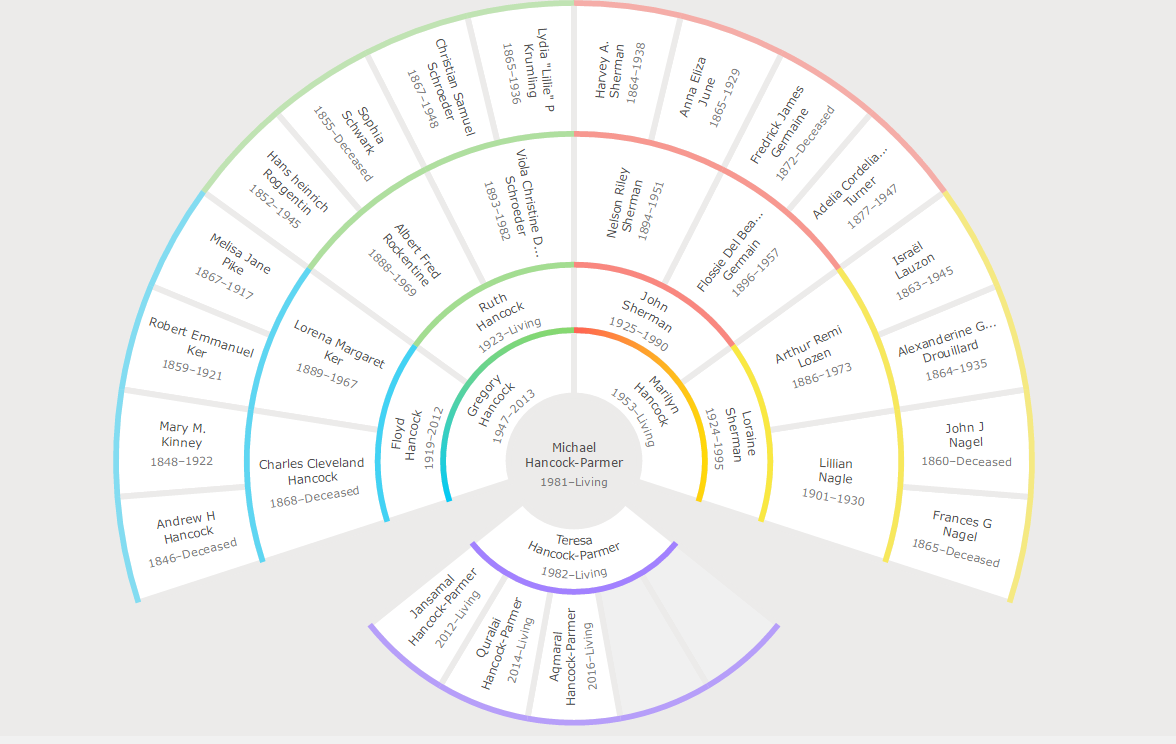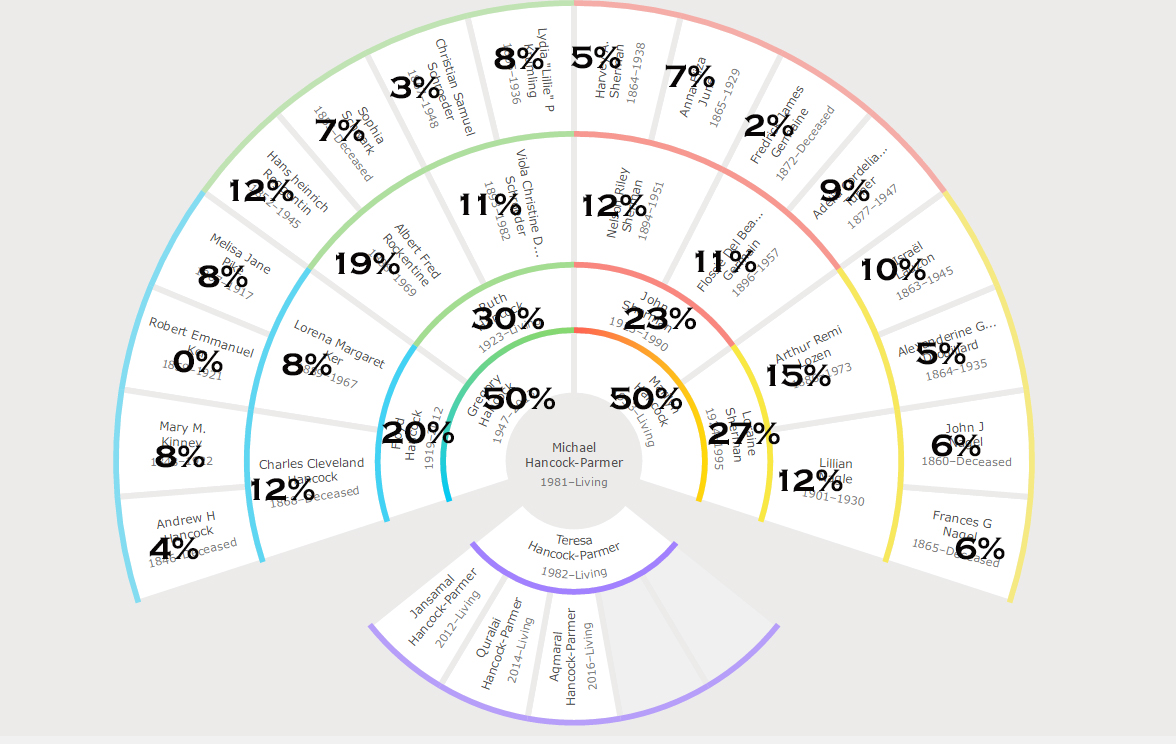Following an introduction to the idea that we actually have no genetic relationship with many of our direct ancestors, we will consider what this means for the promise from genetic-testing companies of finding your “ethnic heritage.”

Imagine that you are on a theater stage, like the one pictured. You are standing in a theater modeled after the Greek and Roman amphitheaters that survive as ruins across the Mediterranean. There is stadium seating for your audience, so that each rank away from the stage is placed about a foot or two above the preceding. Because the amphitheater stretches up and away from you in a rounded bowl shape, each row from the stage has more seats than the one before it.
The first rank of the audience is very unique to you: it seats only your mom and dad. To be more specific, it is your biological father and your biological mother. They have the entire front row to themselves, but stretching back behind them the rows become ever more crowded.
Behind your parents are their parents, in the second row back from the stage. In the third row back from the stage, as you might have guessed, sit their parents– your eight great-grand-parents gathered to see you perform. In the fourth row back sit their parents — your sixteen great-great-grandparents, possibly somewhat confused as to what the fuss is all about.
If we stop there, we can make some observations about your relationships, genetic and otherwise. For starters, there are no siblings present, no step- or half-parents or siblings. Here we see only the most strictly defined idea of parentage. What’s more, we can be fairly certain (to a degree approaching, but not quite, 100% certainty) that you share some human-specific genetic material in common with everyone in the first four rows.
Moving back in the amphitheater, let your gaze move beyond the crowd closest to the stage. In the fifth row sit the parents of your sixteen great-great-grandparents, your thirty-two great-great-great-grandparents. Here we can see a new class of audience members; from this point on, you will find fewer and fewer relatives that have left a trace in your personal DNA. And back and back the amphitheater stretches, each row with double the number of ancestors, reaching a maximum of around two or three million unique ancestors before the population shrinks down to our common ancestors — the first modern humans.
So your ancestors are not related to you? They are, and they are not. They are related to you genealogically, but not necessarily genetically. You exist because they existed (and had children who did the same). They are your direct ancestors, directly above you on your family tree. They are a part of your family. But, still, their human-specific DNA can easily be absent from your own.
To think precisely, we need precise terminology. The terms “gene” and “genetics” can mislead. For example, it is incorrect to say that “we get fifty percent of our genes from each parent” because we actually receive one hundred percent from each parent. Each human being has the same genetic code, after all. This is why mapping “the human genome” is useful — each of us has the same genes. What is individual to each person is the system of alleles.


Exactly fifty percent of your alleles come from your mother, and the other fifty from your father. Put another way, fifty percent of your alleles come from your mother’s family, and fifty percent from your father’s family. Your mother and father in turn received fifty percent from each of their parents… This leads us to incorrectly assume that we receive twenty-five percent from each grandparent, twelve-and-a-half from each great-grandparent, and so on. In reality, however, when you have a child, you are not passing on exactly half of your mother and half of your father! Your DNA is not an even four-way split between your grandparents.
Why? Because when you received your fifty percent of your alleles from your mother, it was not evenly divided between her mom and dad. In other words, in the act of sexual reproduction, half of your genes come from your father and half from your mother, but that half is determined by that specific egg or that specific sperm. For example, each egg is genetically distinct, a different combination of alleles from your mother’s mother and your mother’s father. Each egg was created differently through the act of recombination.
One of the logical results of this variation in the genetic material we receive from our parents is counter-intuitive and very surprising – so I will underline it.
There is a low, but non-zero, chance that one parent gave you the alleles from only one of their parents and not-a-one from the other… making you unrelated to one of your grandparents!
In other words, you are not equally genetically related to each of your four grandparents. It is possible, even statistically likely, that you are barely related to one or more of your great-grandparents. Once we get beyond that into great-great-grandparents, it becomes statistically unlikely that you share genetic traits with each of them. Again, in the extreme, you may not even have such traits in common with one of your parent’s parents!

This is much more common than most realize! Geneticists estimate that once in every four million births, a child has no genetic relationship with one of their grandparents. In the United States alone we might expect to find some 80 people in that situation. The likelihood increases dramatically when we only consider the alleles that we can see with the naked eye: the shape of your nose, the pattern of your freckles, the color of your eyes. Science, then, agrees with reality. How often have some cousins noticed that they share a stronger resemblance with each other than with a sibling?
The past is gone. If ethnic identity was formed in the past, how does it still hang around? Answer: because it is constantly reinvented in the present by those alive in the present. That the past is no longer present is difficult to accept for many people. We recapture the past using many resources — memory, the written word, ruins, and legends. These sources offer glimpses of the past, with limited accuracy. In other words, the past is not a very safe place to store one’s identity.
When companies like 23andme, Ancestry.com, National Geographic, Helix.com, and MyHeritage.com offer to explain (sell?) our identities to us, we should understand the insurmountable limitations they face in doing so. This is especially important to remember considering that these companies charge a lot of money to analyze cheek-moistened Q-tips (starting around $80 and moving upward of $500, depending on the services purchased).

There are three genetic tests on offer: testing Y-chromosomal history (available only to holders of Y-chromosomes, i.e., “biologically-defined men”), testing mitochondrial DNA (mtDNA), and testing your alleles, your “autosomal DNA.” The first two are very specific: Y-chromosome tests reveal only your patrilineal descent, while mtDNA only reveals your matrilineal descent. Both the Y-chromosome and the mtDNA is passed between generations with very few mutations or changes, making them useful for archaeologists and less useful for genealogists. For example, thanks to mtDNA and Y-Chromosome testing, geneticists have estimated that the most recent common ancestor for every human being on earth possibly lived only 2000 years ago.

Haplogroups refer to these two types of tests. They derive from the slow mutation of the Y-chromosome and mtDNA — changes that happen very rarely. In the case of mtDNA, scientists in one study observed an average of 1 mutation (“substitution”) per thirty-three generations, though skepticism remains because the observed rate in genetic studies is much, much slower [quoted here]. Y-chromosomes mutate considerably faster. However, both mtDNA and Y-chromosomes change much more slowly than the genome at large, which is scrambled and re-assembled every generation — so that both of these are used to signify “haplogroups” by geneticists, showing general relationships over large populations.
Genetic haplogroups are not synonymous with ethnicities, races, nationalities, religions, or other identities.
Indeed, Y-chromosome haplogroups and mtDNA haplogroups are quite different (examples HERE and HERE) and do not add new information for the consumer of genetic testing — they largely confirm (or at least do not contradict) the Out-of-Africa hypothesis of human prehistory.
It is the third test that allows people to find more recent relationships and connections with “ethnic identity.” Unfortunately, such tests are limited to the above percentages — what do you do with the fact that so many of your recent ancestors (some of whom lived only 100 or 200 years ago) are not even present in your DNA? Ancestry.com divided the world up into 26 ethnic/genetic provinces, each determined by small samples, sometimes as few as a dozen, rarely more than 100. [Quick read on this here…]
And who is representing these ethnic identities? 23andme and similar companies state that if a subject has been genetically tested and affirms that their four grandparents were from a specific location, that person today is counted as a “native” of that location. In other words, when your genetic results claim that you are 57% Northern European, they mean that your markers have so much in common with the people currently living there… but again, what about their own genetic heritage? They, too, have many in their past whose DNA is absent from the present.
The fact is that the computer analyzing your DNA does not spit out your “identity,” but rather a long string of numbers and letters. This string is in turn analyzed by an algorithm searching for matches in a growing (but finite) database. That matched information is then sent on to a human being to interpret — and this is key. Should you send the same DNA to multiple testing sites, you will find different ethnic backgrounds! For more information on the process of interpretation, see this website. How does this happen?
Simple answer: because ethnicity is not based on science. Science can measure and explain the chemical makeup of your DNA, but it cannot (should not?) measure and explain your genealogical, “ethnic” identity. And much of this science-and-identity is unfortunately filtered through profit-driven companies, to boot…
So, can you tell your ethnic identity from a DNA test? No, not the way you think it can…
If you would like to read examples of the kind of literature I am criticizing in this article, you will find links in this paragraph. Works suggesting that genetics support or prove ethnic identity are commonplace, but I argue they are misleading at best and nationalistic hate-speech at worst. There are, sadly, more iterations of this argument than I can count: you can start HereHereHereHere or Here – and of course the options increase if we search outside the body of English language materials.